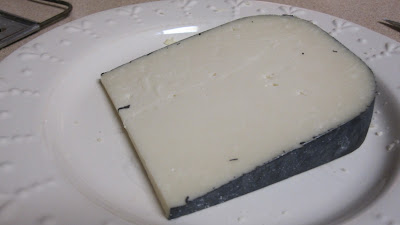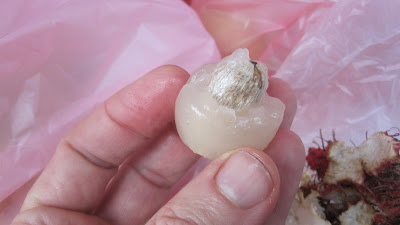While in San Francisco we visited the Cowgirl Creamery in the Ferry Building on the Embarcadero and bought two kinds of cheese, one in particular that was really outstanding. I am a huge Gouda fan. Gouda is a yellow cheese made from cow's milk and is named after the city of Gouda in the Netherlands. It is round and has a mildly sweet and fruity taste and tends to be bland and mellow. Gouda does not have to be made in the Netherlands, it can be and is made all over the world. To make Gouda, cultured milk is heated until the curds separate from the whey. Some of the whey is drained and water is added which is called "washing the curd." It creates a sweeter cheese because some of the lactic acid is removed. It is pressed into a circular mould which gives it its characteristic shape and then it is soaked in brine and then dried. It can be aged from a few weeks to over seven years. Aged Gouda is one of the 1001 Foods You Must Taste Before You Die. With aging, it "takes on entirely new identities." After one year, it starts getting brittle, but can still be sliced with a sharp knife. At five or six years, "it can be as hard as a Parmigiano-Reggiano, packed with a powerful, complex flavor and calcium lactate crystals that make it almost crunchy when chewed." For goat Gouda, the production process is similar. One of the cheeses we got was goat Gouda made at the Central Coast Creamery in Paso Robles.
It is made with goat milk and some added goat cream which gives it additional flavor and perhaps has something to do with its white rather than usual yellow color. It is aged five months or more. The aging makes it semi-hard and a little more grainy.
It has a "slightly nutty, sweet flavor and a caramel aroma." This is one of the most amazing cheeses I've ever tasted. I'm not sure if it is the use of goat milk, the added goat cream, the aging, or most likely the combination of the foregoing, but this is no mild, bland or mellow cheese: it is a taste powerhouse and packs a wallop.
The sharp taste assaults the taste buds like a strong cheddar, overwhelming the mouth like a jalapeno, but in a sweet cheddar-like manner. It is best eaten in very small doses so as to enjoy the spectrum of the taste and physical impact. In larger quantities my mouth was completely overwhelmed and could not appreciate or detect the complexity of it.
The other cheese we got was a Parmigiano-Reggiano made by La Villa Reggiana in the Emilia Romagna region of Italy.
It is made from raw milk of Bruna Alpina and Rossa Reggiana cows and is aged more than two years. It is a hard cheese with deep, rich flavors and is also one of the 1001 Foods.
It was apparently Napoleon's favorite cheese and is an ingredient in pesto, great shaved in salads or eaten in "bite-size chunks." 1001 describes it as having a "wonderful complexity of flavor...[i]nitially salty and nutty, the taste opens up into an intense rich tang with surprisingly subtle fruity notes."
I grilled some Chinese eggplant on our gas grill and added each type of cheese to some pieces, then melted the cheese on the eggplant briefly in the microwave. It was very good, but I found that both types of cheese were best appreciated by themselves, in small quantities.
I recently bought some goat gouda from Trader Joe's, aged 16 months.
I recently bought some goat gouda from Trader Joe's, aged 16 months.
It was not white colored, like that above, but did have the amazing wallop-packed taste.
The taste is very complex, and as with the other, it is best to eat one small piece and wait awhile to get a full appreciation for the taste. I don't think this had the same over-powering effect as the gouda above. I would love to taste them side-by-side. Too much time has passed between them to accurately assess their relative merits.
Rachael recently got some cheese from Cypress Grove Creamery in Arcata, California. One of them was Cypress Grove Creamline Midnight Moon,
a pasteurized gouda made out of goat cheese and aged at least six months. It is made for Cypress Grove in Holland and shipped to the U.S. It was not as strong as either the Central Coast Creamery or Trader Joe's goat goudas, discussed above, but it was still delicious. I know the Trader Joe's was aged substantially longer and I'm guessing the Central Coast Creamery goat gouda was aged longer as well. I can say that I am a major fan of aged goat gouda.




















































